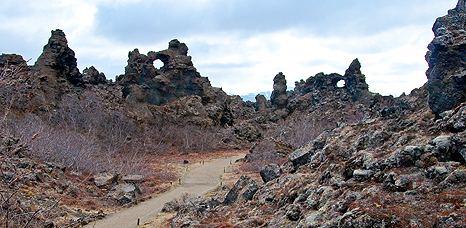Margaret Stephens travelled on our 'Iceland - Gyr Falcons & the Northern Lights' holiday and submitted this entry to our writing competition.
Lava formations at Dimmuborgir by Alan Bevis
Winter Magic
Little did I know when I booked the Naturetrek trip to Iceland, that it would include a magical day when I would be transported to alien planets and the centre of the Earth.
We set off from our hotel, situated by Lake Myvatn, with Malcolm, our tour leader, driving the minibus, our ‘magic carpet’, and immediately entered a world of black and white. It was March and snow blanketed the scenery. Lake Myvatn was frozen, apart from some areas of open water fed by hot springs. Weird, convoluted black lava pillars and pseudo-craters were reflected on these mirror-like surfaces.
Keeping a sharp look out for wildfowl, Ptarmigan and the Gyr Falcon we drove north-east to Dimmuborgir, where we walked down into a hollow surrounded by ancient lava shapes.
Dimmuborgir can be translated as ‘black castles’ and it was possible to imagine these shapes to be castle walls, turrets and arrow-slit windows. Sparse twiggy growth peeped through the snow and the only additional colour was provided by some of the clothing worn by the group. It seemed as if we had been transported into some lunar-like alien planet.
On the Icelandair flight from Heathrow I had seen a short travel film about Northern Iceland. This mentioned strange, long-haired and bearded characters, with names such as ‘Spoon-Licker’ and ‘Sausage-Swiper’, who could be seen there. In this alien landscape I half expected that we might see them peer around the pillars, but alas not. Apparently these ‘Yule Lads’ are the 13 sons of the old trolls Gryla and Leppaluoi and only appear at Christmas, when they go down the mountains to leave small gifts to children, deemed to have been good during the year, in shoes left out on the windowsill, rather like Father Christmas coming down the chimney. However, on climbing back out of the area, I did see a picture of two of them painted on a café wall. Jules Verne wrote his novel ‘Journey to the Centre of the Earth’ in the 19th century long before the discovery of movement of the tectonic plates over the earth’s core. His intrepid travellers climbed down the extinct volcano, Snaefell, on the west coast of Iceland and, after many adventures, but not encountering molten magma, came via the volcano Stromboli in Italy.
We now know that Iceland lies on the Mid-Atlantic Ridge on the junction of the North American and Eurasian plates. Here magma surges up from the Earth’s molten interior and pushes the two plates apart. The mid Atlantic Ridge runs diagonally across Iceland from the Reykanes Peninsula in the south-west in a north-easterly direction to Lake Myvatn and is responsible for the formation of volcanoes and activity such as geysers and mud pools in that area.
The previous evening Malcolm had shown us the video ‘Earth’s Story’ so we were well prepared for our own journey to the centre of the Earth.
On the east of Lake Myvatn there is a hill situated on the Mid-Atlantic Ridge, its summit covered by black lava, the result of volcanic activity many years ago Here pressure from the Eurasian Plate is forcing the North American Plate westward, creating a fissure in the surface, a process known as ‘cracking’.
Below the summit a hole in the lava leads to a cave. This was to be our entrance to the centre of the Earth. Assisted by Malcolm we climbed down into the cave lit by an opening into the fissure. It may have only been several metres down but it was an extraordinary experience, one of the highlights of my tour. Afterwards we climbed up over the lava rocks to peer down into the deep fissure.
Our day of magical destinations had not finished for we continued on to visit the Hverarond area with its mud pools and steam vents. This area looks how Earth may have appeared in its infancy or on some hot alien planet. Colour here was provided by steaming, bubbling indigo mud pools, clouds of steam rising from pyramids of rust and black rocks, and yellow sulphur oozing from fissures in the rocks, and overall there was a strong smell of sulphur. Finally, our ‘magic carpet’ took us to the hot springs at Grjotagja where we had a blissful, relaxing swim before heading back to our hotel. Truly, it had been a magical day.
Read more about our 'Iceland - Gyr Falcons & the Northern Lights' holiday.

 Loading search...
Loading search...
